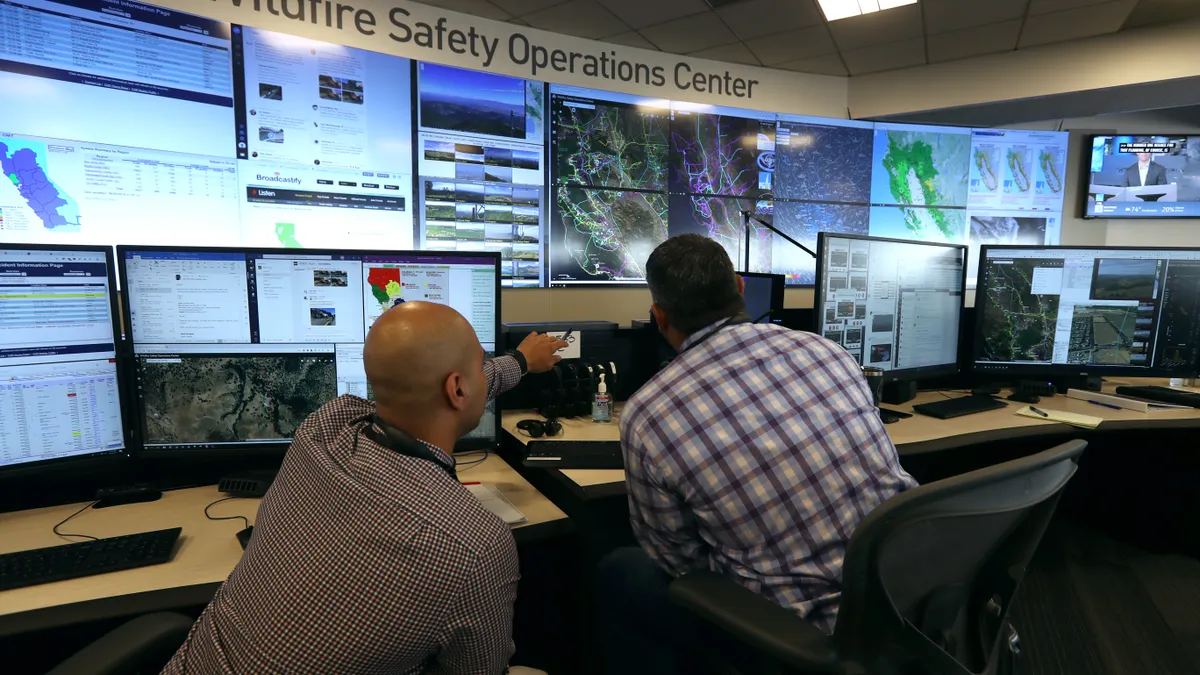Dive Brief:
- Pacific Gas & Electric's (PG&E) equipment may have been involved with a new Northern California wildfire that had burned more than 40,000 acres as of Monday, according to a report that the utility filed with the California Public Utilities Commission (CPUC).
- California officials collected portions of a PG&E 12 kV power line, including conductors, jumpers and insulators, as part of their investigation into the fire, PG&E said in its report. The utility is cooperating with the investigation, which is being conducted by the California Department of Forestry and Fire Protection (Cal Fire).
- PG&E filed the preliminary report "in an abundance of caution" given that its equipment was collected as part of the investigation, utility spokesperson Denny Boyles said in an email. Parent company PG&E Corporation's share price was at $9.21 when markets closed Monday, a nearly 6% drop from the previous close.
Dive Insight:
According to PG&E's Sunday report, the utility detected an outage on its system July 13, and a responding crew member found two blown fuses, a tree leaning into the utility's conductors, and a fire around the base of the tree. State officials were notified and PG&E later turned off the power on another section of the power line at Cal Fire's request. According to the report, the fire has largely burned over remote wildlands and at the time the report was filed had not caused property damage, although it had led to one injury.
PG&E and PG&E Corp. last year exited a 17-month Chapter 11 bankruptcy reorganization process, caused due to billions of dollars in liabilities stemming from fires caused by its infrastructure in 2017 and 2018. The company made a $25.5 billion payout to settle those liabilities, including setting up a trust — funded with $5.4 billion cash and stock representing around 22% of its ownership — to compensate victims of the fires.
Experts, however, have said the utility still faces wildfire-related financial risks. Earlier this year, Cal Fire determined that PG&E's equipment was involved in causing the Zogg Fire, which occurred in September 2020. The Zogg Fire burned more than 56,000 acres and killed four people.
To cope with this risk, PG&E as well as other utilities in California are investing billions in protecting their service territories from wildfires, including by trimming vegetation that is close to their power lines and building more resilient infrastructure. PG&E forecasts spending around $7.4 billion to address wildfire risks from 2023 through 2026, the utility said in its latest general rate case filing, including $3.2 billion in expenses and $4.2 billion in capital.
However, the utility has faced challenges with fire mitigation work in the past — in April, the CPUC voted to place PG&E into a six-step enhanced oversight and enforcement process after an audit identified gaps with the utility's vegetation management work. That process, adopted as a condition of PG&E's bankruptcy exit, could later allow regulators to review, and potentially revoke, its operational certificate.
PG&E's report was met with concern by ratepayer advocacy group The Utility Reform Network. Executive Director Mark Toney said it seems to indicate PG&E is failing to properly manage vegetation around its power lines.
"PG&E is getting billions of dollars to do this work. They're asking for billions more, and it's unacceptable to give PG&E a blank check and not to have results," Toney said.
He urged regulators to increase field inspections, at the expense of utility shareholders, to ensure PG&E is complying with its wildfire mitigation plans.
Some stakeholders have broader concerns about PG&E's strategies for preventing fires in its service area. April Rose Maurath Sommer, executive and legal director of the Wild Tree Foundation, noted that the utility has scaled back the number of miles of power lines it intends to "harden" through a combination of transferring equipment underground, installing covered power lines and building stronger poles.
In 2020, PG&E aimed to harden 220 miles of its system, and completed approximately 342 total miles. This year, however, the utility adopted a new wildfire modeling tool that has changed its thinking around system hardening, according to its latest fire mitigation plan, and it is only targeting 180 miles. That 180 miles, however, represents greater risk reduction than its previous plan, the utility said.
Instead of system hardening, PG&E has "continued with their main focus being on vegetation management," Maurath Sommer said. "Unfortunately, it's been demonstrated over and over again that they just can't seem to get vegetation management right … so this is not new," she said.















